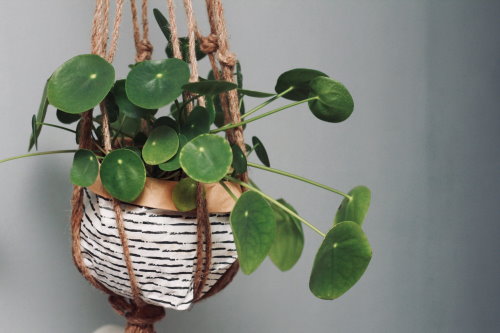Grow Pilea Peperomioides Indoors – Get Chinese Money Plant Care
Botanical Name: Pilea Peperomioides
This eye-catching tropical is sure getting a lot of attention. Once rare and hard to find, Chinese Money Plant has become a must-have houseplant.

Mounds of round, saucer-like leaves shoot out from a central unbranched stem. You don’t need to prune it at all. In fact, this warm-natured West Indies native doesn’t require much care.
You may see tiny, yellow-green flowers during the summer. But they’re not very showy compared to the leaves.
Did you know?
This is a plant that keeps on giving. Pilea peperomioides readily grows offsets that can be separated and potted on their own. Or share them with friends.
See “Propagation” below.
Pilea Peperomioides Problems, Questions and Answers
Wondering whether to repot…or not? Are there roots growing out the drainage holes? Sometimes you have to ease the plant out of its pot and take a peek at its roots. Are they coiled at the bottom? If so, it’s definitely time to repot. Use a pot with drainage holes to avoid soggy soil, which can lead to root rot. If you want to use a decorative planter without holes, use it as a cachepot. Just slip a plain nursery pot in the cachepot. I put small river rocks in the bottom of my cachepots to keep the pot above the drainage water. This has the added benefit of raising the humidity around it — and your plant will love it.
Leaves falling off? Pilea peperomioides will naturally lose a few leaves in winter. If it sheds more leaves than usual, it’s likely caused by cold air or overwatering. Keep it away from drafts and heat/AC vents.
Keep it clean. Wipe dust off leaves when needed with a soft, damp cloth. Dust can interfere with photosynthesis (that’s how plants get the energy they need to grow). Don’t use leaf-shine products. Those bright green leaves are naturally shiny and don’t need it.
Give it a winter rest. Growth slows down in the winter, so it’s a good idea to allow the potting medium to dry out a bit between waterings. Keep plant in bright, indirect light and keep it warm year-round.
Is Pilea peperomioides poisonous? No — it’s non-toxic, and safe for a home with cats and dogs.
Pilea Peperomioides Care Tips
Origin: West Indies
Height: Up to 12 in (30 cm)
Light: Bright light. The foliage will lose its bright green color if the light level is too low. It’s a good idea to place it in bright, indirect sunlight year-round.
Water: Spring through fall, water thoroughly. Use a pot with drainage holes and allow soil to dry out a little between waterings. Over-watering will cause leaves to wilt or fall off. Keep slightly drier in winter when growth is slower. Always use tepid water when watering houseplants.
Humidity: Moderate (around 40% relative humidity) or higher. If indoor air is dry in winter, raise the humidity around your houseplants. Brown leaf tips are caused by dry air.
Temperature: Warm room temperatures 65-85°F/18-29°C year-round. Pilea peperomioides will tolerate a minimum temperature of 55°F/13°C in winter.
Soil: Good-quality peat moss-based potting mix.
Fertilizer: Feed every 2 weeks in spring and summer with a balanced water-soluble fertilizer.
Propagation: Take 3 in (7.5 cm) stem tip cuttings in spring or summer. Cut the stem just below a node — the place where a leaf is attached. Nodes contain cells that will grow roots. Place the cut end in moist potting mix and cover the plant loosely with a plastic bag to retain humidity. Cuttings root easily in about a month. P. peperomioides also grows offsets in abundance — just separate them from the parent plant and pot them.




